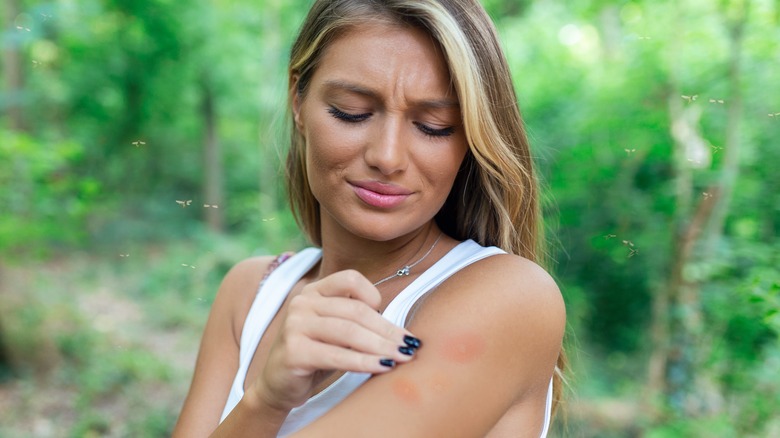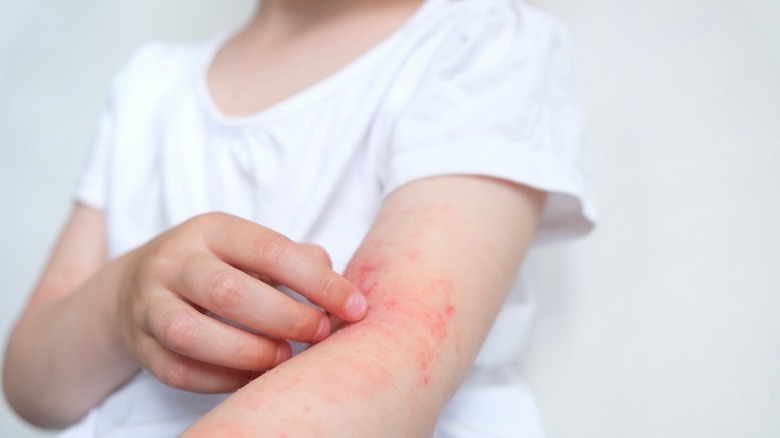How To Prevent Margarita Rashes As We Head Into Warmer Months
Summer is upon us, which means preparing our skin to be healthy while at the beach and planning hours of sitting outdoors, guzzling margaritas. In the midst of this, unsightly skin sores may rank as the last thing on our wish list, but a peculiar summer ailment known as the "margarita rash" is a serious skin concern you shouldn't ignore.
Known as phytophotodermatitis, margarita rashes occur when the skin reacts after coming in contact with certain plants or fruits and being exposed to concentrated sunlight soon after the contact. "The term 'phyto' means plant, 'photo' refers to light, and 'dermatitis' is the inflammation of the skin," Dr. Keira Barr, a dual board-certified dermatologist and founder of Resilient Health Institute told Healthline.
Its colloquial name, "margarita rash," owes its origin to the fact that citrus fruits like limes, lemons, and grapefruit usually cause it. When they leave a residue on your skin just before the sun's UVA rays touch it, a chemical reaction leads to a reddish, blotchy rash.
Hence, the simplest way to prevent margarita rashes as we head into warmer months is to be extra careful when handling citrus fruits. Dr. Dendy Engelman, a board-certified cosmetic dermatologist and Mohs surgeon at the Shafer Clinic in New York City tells Allure that phytophotodermatitis can only be caused when these plants touch the skin, so be careful around your margaritas as you make them, and wash your hands right after.
The chemical reaction that causes margarita rashes
When the sun's UV rays hit the portion of the skin on which the citrus juices have fallen, it activates a chemical known as furocoumarins, commonly found in plants and fruits. This, in turn, triggers an inflammatory response in that particular area. Parsley, grapefruit, and lime are the citrus fruits known to have the highest concentration of furocoumarins, as are certain types of weeds.
As this chemical is only activated when exposed to UV rays, you cannot develop margarita rashes simply by drinking margaritas or eating your favorite fruits. While speaking to Allure, Dr. Engelman also emphasized that although a splash of lime juice that mistakenly falls on the skin can cause these rashes, there is a greater risk of contracting it while "hiking, gardening, or participating in outdoor activities in wooded areas that are home to those offending weeds." Those with a history of contact dermatitis, or those who "work or exercise frequently outdoors may be at a greater risk for the reaction," she adds.
With the summer season upon us, arming yourself with this knowledge will help you prevent margarita rashes.
What to expect and how to treat it
Typical symptoms of phytophotodermatitis include a burn or red rash, which can sometimes become pigmented or brown, as per ABC News. Dr. Carolyn Jacob who has a private dermatology practice in Chicago told ABC News, "I've seen patients where it's still pink in one area and then it's turning brown in one area. We don't understand why it leads to hyperpigmentation."
Information shared in Healthline shows that those with a mild case of margarita rashes may never even notice it, as with time the condition may clear up on its own. Everyday Health outlines the symptoms as "blisters or red, itchy patches on your skin, with symptoms at their worst within two to three days." They recommend making an appointment with your dermatologist to ask about the use of topical steroid creams or a cold compress to ease the pain. While doctors are adept at diagnosing margarita rashes through examination, its appearance can sometimes be mistaken for other dermatological conditions.
Sunscreen may also not help prevent the rashes from taking place because it "doesn't protect against UVA as well [as it does] UVB," says Bruce Robinson, MD, board-certified adult and pediatric dermatologist, clinical professor of dermatology at Lenox Hill Hospital in New York City, and spokesperson for the American Academy of Dermatology, speaking to Everyday Health. So, washing your hands right after making those margaritas is your safest bet for prevention.


